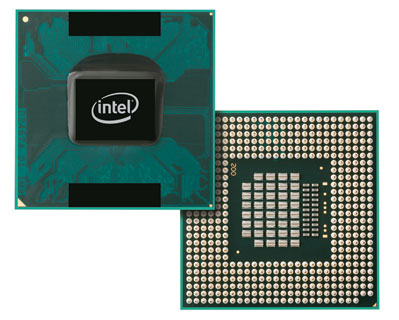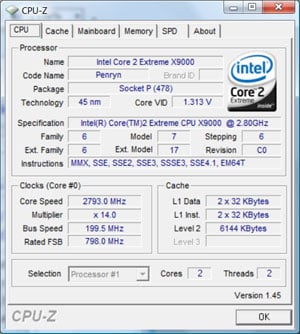Good, bad or indifferent, this is very much the tact that Intel has taken with their Santa Rosa notebook platform, utilizing the 965 Express chipset to enable 65nm Merom dual core processors over various clock speeds up to 2.8GHz, with the Core 2 Extreme X7900 currently sitting atop Intel's 65nm mobile chip offering. Also, earlier in Q1 of this year, Intel drove their new 45nm Penryn dual-core offerings down through their notebook lineup with Wolfdale-like derivatives from 2.1GHz to 2.6GHz and an 800MHz FSB with 3 - 6MB of L2 cache, depending on model number.
Today we have a look at Intel's new top-of-the-line Core 2 Mobile chip, the Core 2 Extreme Mobile X9000. At 2.8GHz with a full 6MB of L2 cache and a TDP of 35 Watts, this chip is currently Intel's fastest notebook CPU for the performance enthusiast, gaming, and multimedia markets, aka the Desktop Replacement (DTR) crowd. Our test vehicle was none other than Dell's XPS M1730 killer mobile gaming machine. A match made in heaven? Perhaps. Read on...



Dell's XPS M1730 - Now Mobile Penryn Infused
|
|
|
|
|
Model L2 Cache Frequency FSB TDP Core 2 Extreme X9000 6 MB 2.8 GHz 800 MHz 35W Core 2 Duo T9500 6 MB 2.6 GHz 800 MHz 35W Core 2 Duo T9300 6 MB 2.5 GHz 800 MHz 35W Core 2 Duo T8300 3 MB 2.4 GHz 800 MHz 35W Core 2 Duo T8100 3 MB 2.1 GHz 800 MHz 35W
Intel 45nm Core 2 Duo Mobile Products
In the specs list above you can see that this new notebook chip from Intel shares nearly an identical features list to that of the higher-end Core 2 Duo desktop chips based on Intel's Wolfdale core. However, Intel has also further enhanced this chip's power-savings capability by turning down FSB speeds to 800MHz and introducing various stages of Intel Speedstep C1 - C4 technology as well as Enhanced Deeper Sleep and Deep Power-Down states. In the processor's Deeper Sleep state, all data that resides in L2 caches is dumped to main system memory and then the cache is powered down as well to conserve power. L2 cache is high speed, low latency SRAM technology that consumers significantly more power than a standard DRAM cell. Powering down the cache also allows the Northbridge memory controller to stop making requests thus offering this "deeper" sleep state since it doesn't have to wake the processor up looking for L2 cache data that isn't there anyway.
| Overclocking The Core 2 Extreme Mobile X9000 |
| The Fastest Notebook Chip To Date... |
We then took a look under this new mobile chip's hood with the help of CPU-Z. As you'll note, the model, stepping and revision numbers listed are identical to that of Intel's Wolfdale core architecture. However, CPU-Z only recognizes this new chip as a "Penryn" core and technically that is not an incorrect designation.


Core 2 Extreme Mobile X9000 Processor - Stock 2.8GHz and Overclocked @ 3.2GHz
As you can see, the processor's multiplier is relatively high. At stock speeds, a multiple of 14X is applied to an 800MHz quad-pumped 200MHz bus speed. By turning up the multiplier to 16X, we were able to achieve a completely stable 3.2GHz clock speed without the need of a core voltage increase, though the M1730's fans were spun up to unbearably loud levels. We'd recommend a quieter 3GHz overclock, which didn't require a fan speed increase for stability. Also, though a 17X multiplier was available in the BIOS for a 3.4GHz clock speed, the system wouldn't remain stable for extended periods of testing and benchmarks.
With the system plugged into a wall-plug power meter, we measured total system power consumption at stock and also at various overclocked speeds all the way up to 3.4GHz. You may be surprised with the results, especially in comparison to one of our reference systems.

Core 2 Extreme Mobile X9000 Processor - Full Load
At its stock speed and with the ability to invoke the various stages of its power savings features, the M1730 system, with the Core 2 Extreme Mobile X9000, has significantly lower power consumption versus our standard Core 2 Duo E6600 test system. And frankly our test systems are stripped down comparatively, without an LCD panel drawing power from the same connection like the notebook is limited to. This speaks clearly for those of you concerned about "Green Computing". Want to really cut down on your carbon footprint? Simply go the way of the notebook. Or better yet, go with a low power 45nm mobile CPU in that notebook as well.
For our overclock-enabled tests, you'll observe that since the processor's multiplier has been hard set, clock gating doesn't occur under either load or idle conditions. Regardless, even heavily overclocked, the Dell XPS M1730 with the Core 2 Extreme Mobile X9000, relatively speaking, consumes a lot less power than a similarly configured desktop system. Though you might want to keep this humdinger of a notebook tethered to the wall because battery life time is only around an hour and 15 minutes or so.
For our next set of tests, we moved on to some in-game benchmarking with Crysis and F.E.A.R. For testing purposes, with Crysis or F.E.A.R., we drop the screen resolution to 800x600, and reduce all of the in-game graphical options to their minimum values to isolate CPU and memory performance as much as possible. However, the in-game effects, which control the level of detail for the games' physics engines and particle systems, are left at their maximum values, since these actually do place some load on the CPU rather than GPU.
|
|
|

In what arguably can be thought of as the most demanding game engine to date, the Core 2 Extreme Mobile X9000 CPU shows it has just as much fight in it, if not more than our dual-core desktop CPUs. The 2.8GHz stock speed X9000 numbers clock in right next to the 3GHz Core 2 Duo chip and far ahead of the tri-core Phenom. At 3.2GHz, this 478-pin mobile chip toasts the 3GHz desktop chip by a solid 20% margin.


No comments:
Post a Comment